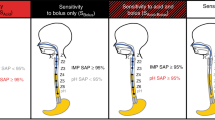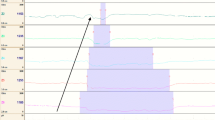Our aims were to compare the specificity and sensitivity of the reflux index (RI), Euler and Byrne score (EBS), and area under the curve (AUC) at pH < 4.0 in infants 1 year old for identifying pathologic gastroesophageal reflux (GER) and to identify new cutoffs on formula feedings. We undertook a prospective investigation of extended pH monitoring (EPM) in 117 infants with symptoms of GER. Infants were categorized as having pathologic reflux by three measures: RI ≥ 5%, EBS ≥ 50, or AUC pH < 4.0 or ≤ 21.3, as determined by receiver operating characteristic (ROC) curve analysis. Using the RI as a criterion, 27 infants (23%) had pathologic reflux. When EBS and AUC were used, 65 (56%), and 67 (57%) respectively, were classified as having pathologic reflux. The specificities of RI, EBS, and AUC were 97.8, 100.0, and 100.0%, respectively, and the sensitivities were 93.0, 91.5, and 94.4, respectively. A new cutoff value for RI of 2.1% was determined using ROC curve analysis to improve the specificity and sensitivity of RI to the above values. The number of infants with pathologic GER is likely to be significantly less using the traditional RI alone on formula feedings, however, the revised RI cutoff value and AUC analysis by computerized pH tracings can enhance the accuracy on formula feedings.
Similar content being viewed by others
References
Tolia V: Evaluation and management of pediatric gastroesophageal reflux. Fam Pract Recert 19:35–57, 1997
Rudolph C, Mazur LJ, Liptak G, Baker RD, Boyle JT, Coletti RB, Gerson WT, Werlin SL: Guidelines for evaluation and treatment of gastroesophageal reflux in infants and children: Recommendations of the North American Society for Pediatric Gastroenterology and Nutrition. J Pediatr Gastroenterol Nutr 32 (Suppl 2):S1–S31, 2001
Mahajan L, Wyllie R, Oliva L, Balsello F, Steffen R, Kay M: Reproducibility of 24-hour intraesophageal pH monitoring in pediatric patients. Pediatrics 101:260–263, 1998
Working Group of the European Society of Pediatric Gastroenterology and Nutrition: A standardize protocol for the methodology of esophageal pH monitoring and interpretation of the data for the diagnosis of gastroesophageal reflux. J Pediatr Gastroenterol Nutr 14: 467–471, 1992
Colleti R, Christie D, Orenstein R: Indications for pediatric esophageal pH monitoring. J Pediatr Gastroenterol Nutr 21:253–262, 1995
Sondheimer JM: Continuous monitoring of distal esophageal pH: A diagnostic test for gastroesophageal reflux in infants. J Pediatr 96:804–807, 1980
Arusu TS, Wyllie R, Fitzgerald JF, Fraken EA, Siddiqui AR, Lehman GA, Eigen H, Grosfeld JL: Gastroesophageal reflux in infants and children: comparative accuracy and diagnostic methods. J Pediatr 90:798–903, 1980
Boix-Ochoa J, Fajuente JM, Gilt-Vernet JM: Twenty-four hour esophageal pH monitoring in gastroesophageal reflux. J Pediatr Surg 15:74–78, 1980
Vandenplas Y, Francky-Goossens A, Pipeleers-Marichal M. Derde MP, Sacre-Smits L: Area under pH 4: Advantages of a new parameter in the interpretation of esophageal pH monitoring data in infants. J Pediatr Gastroenterol Nutr 9:34–39 1989
Tovar JA, Izquierdo MA: A single figure parameter representative of esophageal acid exposure. J Pediatr Surg 2:163–167, 1991
Euler AR, Byrne WJ: Twenty-four hour esophageal intraluminal pH probe testing: A comparative analysis. Gastroenterolgy 80:957–961, 1981
Strobel C, Byrne W, Ament M, Euler AR: Correlation of esophageal lengths in children with height: application to the Tuttle test without prior esophageal manometry. J Pediatr 94:81–85, 1979
Metz CE: Basic principles of ROC analysis. Sem Nucl Med 8:283–298, 1978
Bell NJV, Burget D: Role of gastric acid suppression in the treatment management of gastroesophageal reflux disease. Gut 33:118–124, 1992
Howden CW, Burget DW, Hunt RH: Appropriate acid suppression for optimal healing of duodenal ulcer and gastro-esophageal reflux disease. Scand J Gastroenterol 29 (Suppl):79–82, 1994
Tuttle SG, Grossman MI: Detection of gastroesophageal reflux by simultaneous measurement of intraluminal pressure and pH. Proc Soc Exp Biol Med 98:225–227, 1958
Jolley SG, Johnson DJ, Herbst JJ, Pena A, Garnier R: An assessment of gastroesophageal reflux in children by extended pH-monitoring of the distal esophagus. Surgery 84:16–24, 1978
Vandenplas Y: Esophageal pH monitoring for gastro-esophageal reflux in infants and children. Chichester, J. Wiley, 1992, pp 56–66
Tovar JA, Eizaguirre I, Wang W: Automatic measurement of the “Area Under the Curve” in the diagnosis of gastroesophageal reflux. J Pediatr Gastroenterol Nutr 17:345–346, 1993
Mitchell DJ, McClurre BG, Tubman TRJ: Simultaneous monitoring of gastric and oesophageal pH reveals limitations of conventional oesophageal pH monitoring in milk fed infants. Arch Dis Child 84:273–276, 2001
Carroccio A, Cavataio F, Acierno E, Montalo G, Lorello D, Tumminello M, Soresi M, Livoti G, Iacono G: Use of 24-hour esophageal pH-metry for the detection of gastro-esophageal reflux in infants: What is the ideal score and the optimal threshold?. A receiver-operating characteristic analysis. Ital J Gastroenterol Hepatol 29:297–304, 1997
Vandenplas Y, Sacre L: Continuous 24-hour esophageal pH monitoring in 285 asymptomatic infants 0–15 months old. J Pediatr Gastroenterol Nutr 6:220–224, 1987
Dinelli M, Passaretti S, Francia ID, Fossati D, Tittobello A: Area under pH 4: A more sensitive parameter for the quantitative analysis of esophageal acid exposure in adults. Am J Gastroenterol 94:3139–3144, 1999
Janssens J, Vantrappen G, Vos R, Ghillebert G: The acid burden over an extended period preceding a reflux episode is a major deteminant in the development of heartburn. Gastroenterology 102:A90, 1992
Vandenplas Y, Goyvaerts H, Helven R, Sacre L: Gastroesophageal reflux, as assessed by 24-hour pH monitoring in 509 healthy infants screened for SIDS-risk. Pediatrics 88:834–840, 1991
Jamieson JR, Stein HJ, DeMeester TR: Ambulatory 24-h esophageal pH monitoring: Normal values, optimal thresholds, specificity, sensitivity and reproducibility. Am J Gastroenterol 87:1102–1111, 1992
Author information
Authors and Affiliations
Corresponding author
Rights and permissions
About this article
Cite this article
Tolia, V., Wuerth, A. & Thomas, R. Diagnostic Interpretation of Extended pH Monitoring: Is There a Single Best Method?. Dig Dis Sci 50, 94–99 (2005). https://doi.org/10.1007/s10620-005-1284-y
Received:
Accepted:
Issue Date:
DOI: https://doi.org/10.1007/s10620-005-1284-y




